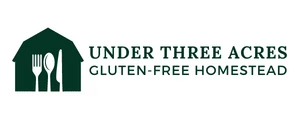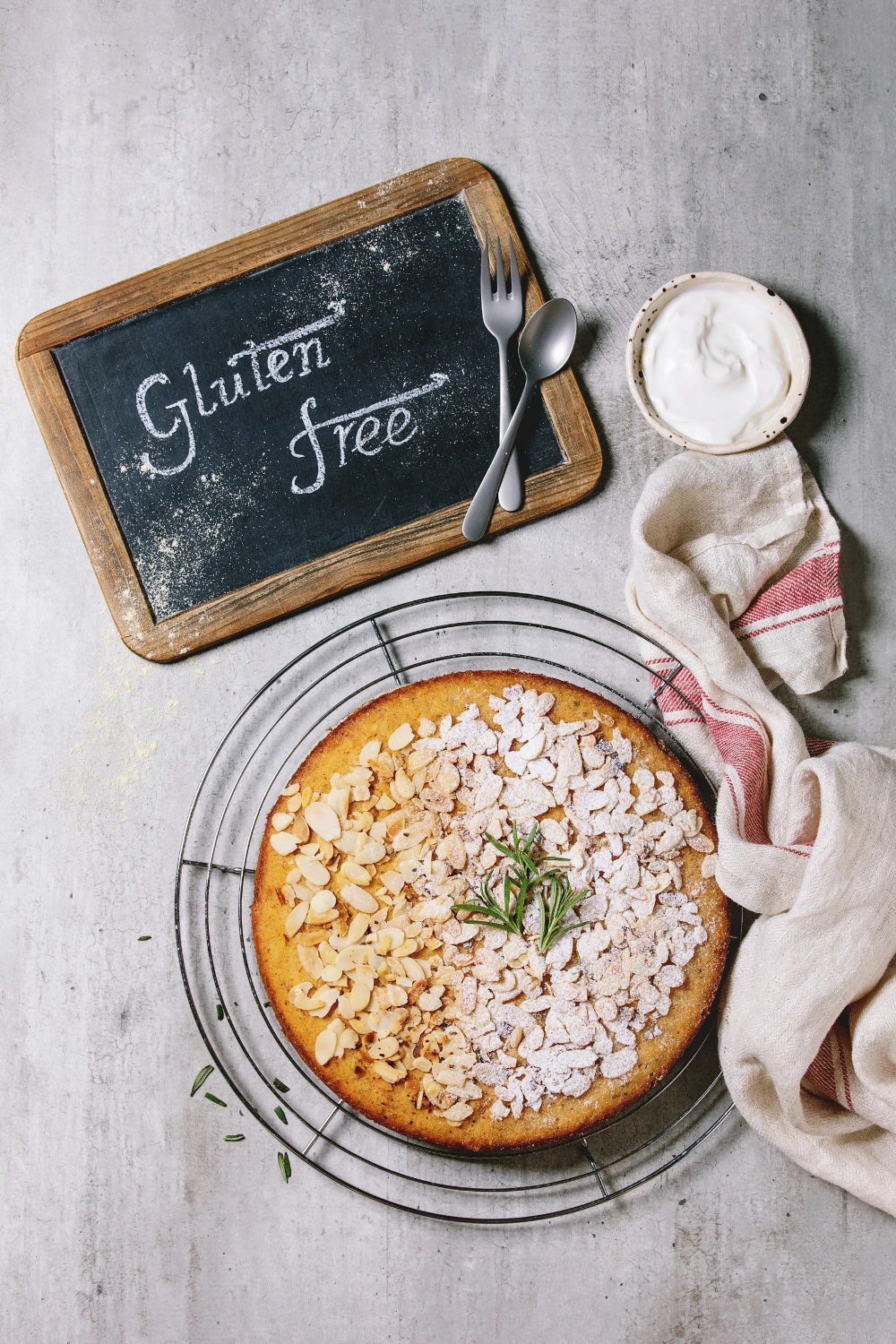
WELCOME TO UNDER THREE ACRES
Let’s talk about the gluten-free diet, shall we?
Well, I’m assuming that’s why you’re here. You or a loved one can no longer consume gluten and you are looking for answers. Start here on this page to get some of the answers.
I have put together as much gluten free diet information as possible in one place to get you started on a gluten-free diet. The following resources and links will serve as a guide to becoming familiar with what you can eat and what foods to avoid on a gluten-free diet.
But before I share with you my favorite tips, research, and resources, I must tell you that I am not a doctor, nor am I in any position to give you medical advice. The following information is based on my own research and I encourage you to do your own research.
I share this information because I once stood in your shoes. My oldest son and I found out in 2008 that gluten was what was causing us to be very ill. I want to help you find answers and help you to start to enjoy food again. You can read more about our gluten-free journey here.
I’m so glad you’re here! Let’s get you started on the road to a life without gluten that doesn’t involve pain or disgusting food.
Gluten Free Diet 101
Starting a gluten-free diet can be challenging and overwhelming if you don’t know what you can and cannot eat. A strict gluten-free diet is the only effective treatment for celiac disease, non-celiac gluten sensitivity, dermatitis herpetiformis, and can help in the treatment of other autoimmune diseases such as Hashimoto’s thyroiditis.
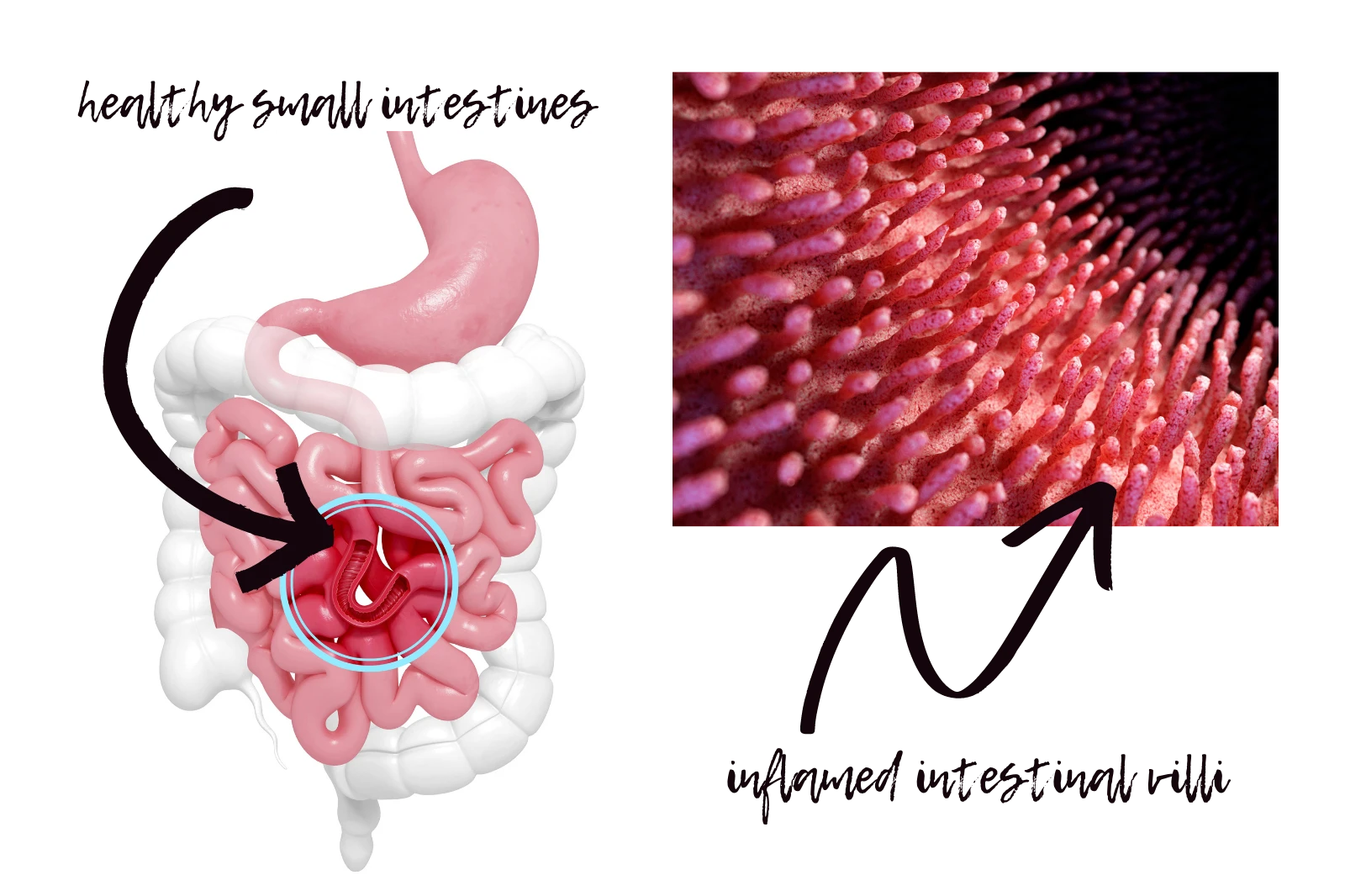
For some people, gluten triggers an immune response. This immune response is what damages the villi in the lining of the small intestines and makes it hard for the body to absorb nutrients, leading to malnutrition and causing a person to feel a variety of symptoms, which may include any or all of the following:
- abdominal pain
- anemia
- anxiety
- bloating
- bone and joint pain
- brain fog
- chronic fatigue
- chronic headaches
- constipation
- depression
- dermatitis
- diarrhea
- epigastric pain (pain just below the ribcage)
- gas
- gastroesophageal reflux
- muscle cramps
- neuropathy (pins and needles feeling in arms and legs)
- skin rash
- weight loss
What is gluten?
The word gluten comes from the Latin word for glue and is what gives dough its elastic and sticky properties. Gluten is a protein that is naturally found in some grains including wheat, rye, and barley but occurs naturally in the following less common grains such as…
- spelt
- kamut
- farro
- durum
- emmer
- bulgar
- semolina
- triticale
- dinkel
- einkorn
- farina
- couscous
- oats*
The proteins in wheat (gliadin), rye (secalin), barley (hordein), and the grains above are similar and all come from the same subfamily of grass plants. *The protein in oats (avenin) is typically listed as not containing gluten. However, regular commercial oats can be contaminated with wheat, barley, rye, and other grains.
This contamination can occur at any time in the process. A combine harvester used to harvest wheat can be used to harvest oats and cause contamination, but contamination can also occur in the processing or packaging plant where oats are processed using the same machines as gluten-containing ones. This is what is referred to as cross-contamination. For this reason, companies that sell certified gluten-free oats use dedicated farm equipment and factory processing plants.
A small number of people with Celiac disease are not able to tolerate pure, uncontaminated certified gluten-free oats. The reason for this is unclear. Although oats are considered a gluten-free grain, there is a chance that you may develop symptoms consuming pure uncontaminated oats. The Canadian Celiac Association has a statement on Oats and Celiac Disease and in Australia, oats are not considered gluten-free at all.
Foods to Avoid on a Gluten Free Diet
In addition to the grains listed above, there are a number of foods and/or ingredients that you will need to avoid. It is imperative that you learn how to read food labels. Here in Canada, the food labeling laws require that gluten and the most common allergens are listed on the food labels. However, it is always best to err on the side of caution to avoid being contaminated with gluten, especially if your country’s food labeling laws don’t require strict transparency.
This list is pretty extensive, but if you are aware of a food or ingredient that I have missed, please don’t hesitate to contact me.
- atta (chapatti flour) used to make an unleavened bread known as roti, rotli, safati, shabaati, phulka and roshi
- barley listed as: flakes, flour, or pearl
- beer, ale, lager (when made from barley, wheat, and/or rye)
- breading, bread crumbs, croutons, bread stuffing, toasted wheat crumbs, panko
- Brewer’s yeast
- dextrin, or maltodextrin derived from wheat
- freekeh, farik, or frik
- Fu, a Japanese specialty made of solidified wheat gluten
- graham flour, graham crackers, graham cracker crumbs
- hydrolized wheat protein
- malt, malt extract, malt syrup, malt flavoring, malted barley, matled barley flour, malt vinegar, malt milk
- Matzoh, matzoh meal
- modified food starch
- modified wheat starch
- MSG also known as monosodium glutamate when made using gluten containing cereal grains
- oatmeal, rolled oats, oat bran, oat flour, oat groats (see above for information on oats)
- pasta noodles, egg noodles, soups with noodles
- Seitan also known as miàn jīn, milgogi, wheat meat, gluten meat, vital wheat gluten
- wheat bran, wheat berries, wheat flour, wheat starch, wheat gluten
Common Foods That May Contain Hidden Gluten
Many of the packaged and processed foods in the grocery store as well as many common dishes found in restaurants or fast-food joints contain hidden gluten under the guise of the ingredients listed above. It is important to read the labels or enquire about the following:
- alcoholic and non-alcoholic beverages
- baby formula, baby foods
- baked goods and baking powder
- breading and coating mixes
- broth, soup, bouillion, stock cubes
- burgers, meatballs, meatloaf
- canned meats and fish
- cereals, granola, pancake, waffle & baking mixes, pancake and fruit syrups
- confectionary, candies, chocolate bars, gummy bears, licorice, chewing gum
- crackers, graham crackers, pretzels
- deli meats, sausages, hot dogs, jerky
- flavored coffee, tea, sports drinks, malt based beverages, protein powders
- flavored tofu, meat substitutes, fried food using oil also used for gluten-containing products
- fries, onion rings, battered fish, deep fried vegetables
- fruit with sauces, smoothies, barley grass or wheat grass
- hot cereal and infant cereals made with wheat, rye, triticale, barley, oats
- imitation meats, imitation seafood
- ice cream, ice cream cakes, frozen desserts, yogurt with granola toppings
- mayonaise, sandwich spreads
- medications and nutritional supplements
- noodles, pasta, ramen, dumplings, gnocci
- nut and seed butters, plant based spreads
- potato chips, flavored popcorn
- poutine, pizza, tacos, buritos
- preseasoned or prebasted meats
- tv dinners, ready made meals
- tortillas, croutons
- thickeners, gravies
- scalloped potatoes, vegetables in sauces, packaged vegetables
- seasonings, seasoned mixes, seasoned nuts or seeds
- sour cream, cheese spreads, shredded cheese, dips
- snack foods, pudding mix or cups, granola bars, protein bars
- soy sauce, tamari, teriaki, bbq sauces, Worchestershire sauce, marinades, salad dressings
If you are preparing food for someone else who is celiac or someone who needs to be on a gluten-free diet for health reasons, please note that even a tiny speck of gluten can cause damage to the small intestines in addition to causing that person to suffer unnecessarily.
Foods That Are Naturally Gluten-Free
You are probably thinking, “What can I eat on a gluten free diet?” There are a number of foods that are gluten-free by nature, starting with simple fruits, vegetables, fresh meat, fish, nuts, and seeds.
When you are just starting out on a gluten-free diet, it can be very tempting to go to the store to purchase pre-packaged gluten-free mixes, ready-made meals, and your favorite snacks that are gluten-free. These items although ‘safe’ can be very expensive and often have very little to no nutritional value.
Many foods are naturally gluten-free and can help you get started as you navigate your way around label reading and finding recipes that you enjoy.
Unprocessed meats, fruits, and vegetables are a great place to start. There are also a number of gluten-free grains, nuts, seeds, legumes, starches, eggs, dairy, and healthy fats that are inexpensive and easy to obtain.
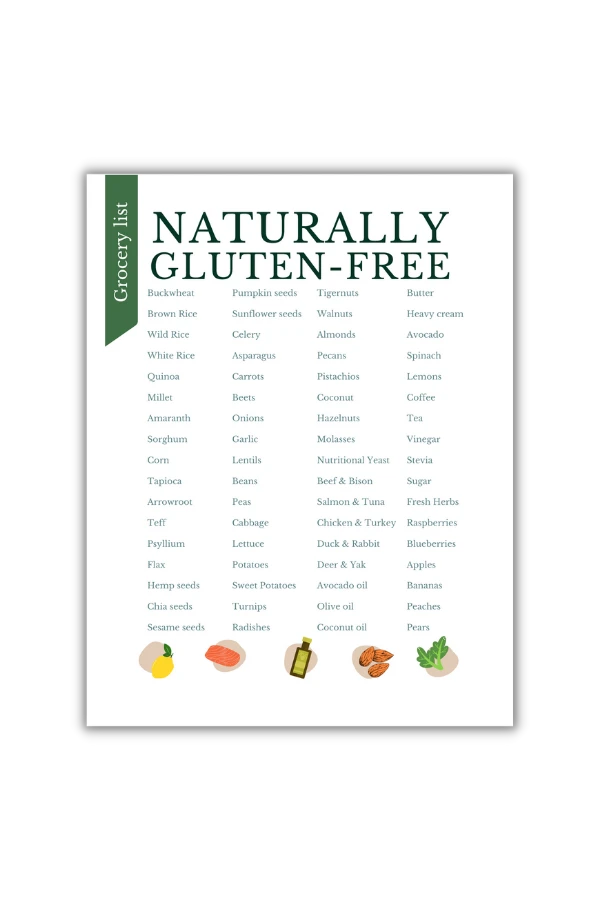
f you are looking for more tips and ways to save money on your next grocery bill, be sure to grab the FREE GUIDE below.
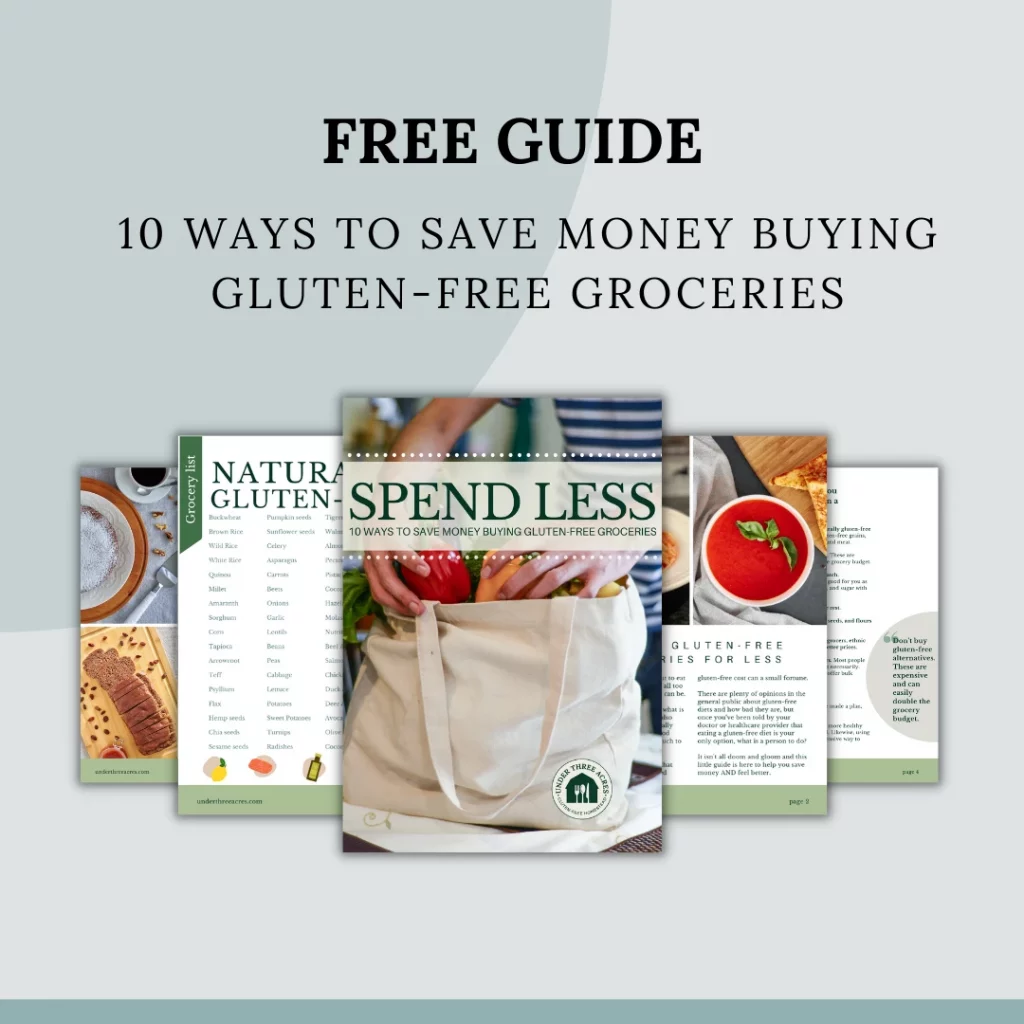
Download your guide and start saving money on groceries today!
This eBook is full of tips, a grocery list, and simple recipes to help you save money buying gluten-free groceries so that you can enjoy great food with your friends and family.
Tips For Reading Gluten-Free Labels
Although it is easy to say that the best way to go gluten-free is to cook everything from scratch from items that are naturally gluten-free, it is simply not realistic in today’s world. You need to have options for ready-made items to make your life easier.
Ingredients can, unfortunately, change at any time, so it’s important to read labels every time you shop. The following tips will help you narrow down your search for safe foods to eat. Here are 5 tips for reading labels to help you find food that is safe to eat on a gluten-free diet.
Check for third-party certification on the packaging. A product that is labeled with a third-party, gluten-free certification, such as Gluten-Free Certification Organization (GFCO)’s mark, is considered safe for gluten-free consumers.
1.
Check for third-party certification on the packaging. A product that is labeled with a third-party, gluten-free certification, such as Gluten-Free Certification Organization (GFCO)’s mark, is considered safe for gluten-free consumers.
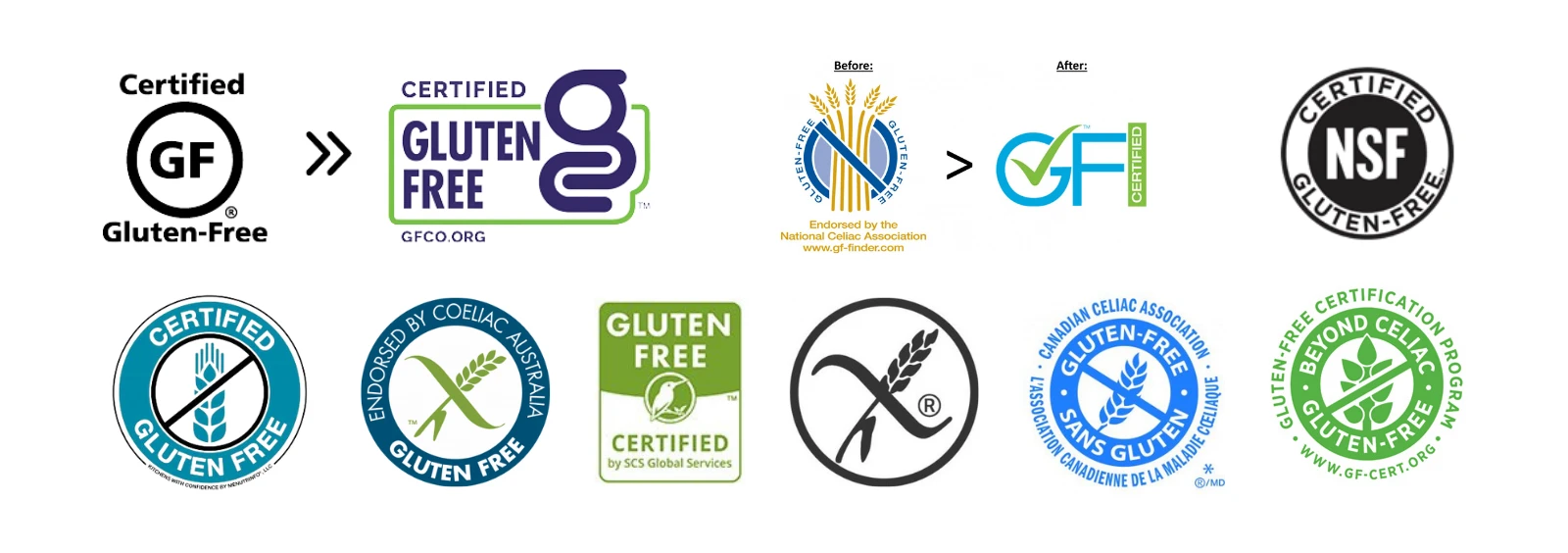
Buyer beware, not all gluten-free labels are created equally. The ones listed above are examples of third-party certification labels. That means that the products bearing the label have undergone third-party investigation and tests to prove they are in fact gluten-free with allowances of up to 20ppm (parts per million). Different labels have different thresholds of how many ppm are allowable, but <20ppm is considered by international standards to be gluten-free.
In some countries, manufacturers claim a product to be gluten-free and label it as such. In these cases, gluten-free labeling is only a declaration, and not necessarily a certification. Simply put, the manufacturer claims to abide by the national GF ruling does not mean the product actually went through a thorough testing or certification process.
2.
Look for the words “gluten-free” on the packaging. If a product claims to be gluten-free, it likely is.
3.
Read the ingredients list. Once you are familiar with which ingredients are safe and which are not, it will be easier to determine whether a product is gluten-free or not. Many canned goods are not labeled GF or certified GF because they don’t contain gluten in the first place (ie. stewed tomatoes, coffee grounds, applesauce).
As I mentioned earlier, here in Canada, the food labeling laws require that gluten and the most common allergens are listed on the food labels. Look for labelings such as May Contain… wheat, barley, rye, or oats.
4.
Download an app on your phone to detect gluten in products. A few popular ones are Gluten Free 24/7, AllergyEats, and Spoonful: Food Scanner. These are helpful but not always 100% reliable, especially if you live in a different country than the app creator.
5.
Plan your shopping ahead and check products in a directory like the Certified Gluten-Free Product Finder on gluten.org. If you grocery shop online using an app, the labels or lists of ingredients are often available in the app. If your app allows, uncheck “allow substitutions” so that you don’t end up with a gluten-containing alternative if the product in your cart is out of stock.
In time, you will become an expert label reader. You will find the products that you and your family like and trust. In the beginning, it is helpful to join some gluten-free or celiac groups online. Many people will share photos of products that met their expectations and will inform you of those to avoid.
What Are The Side Effects Of Going Gluten-Free?
This will all depend on your condition, whether you have celiac disease, non-celiac gluten sensitivity, or other autoimmune disorders. It will also depend on the severity of your symptoms and the amount of damage your intestines have incurred before going on a gluten-free diet.
If your doctor or health care provider has recommended a gluten-free diet, it is most likely to reduce the symptoms or severity of the symptoms experienced by the affected patient. Some of the most comment side effects of going gluten-free include:
- less bloating, gas, diarrhea, and a significant reduction in abdominal pain and discomfort
- an increase in constipation
- increased concentration and less ‘brain fog’
- an increase in hunger
- an increase or improvement in energy
- fluctuation in weight
- withdrawal symptoms
- less joint pain and inflammation
- clearer skin
- increased fertility, or change in your menstrual cycle
- improved absorption of nutrients
- stronger immune function
It can take anywhere from a couple of days to even six months to heal. It all depends on the severity and the level of inflammation of the individual. I often hear people say that tried going gluten-free, but it didn’t work. When the doctor tells you to go gluten-free, that means all the time without cheating. It takes time to heal. While some may experience a vast improvement in a couple of days, that is not the case for everyone.
If you aren’t cheating or accidentally getting cross-contaminated and don’t see any improvement in your symptoms after a couple of weeks or are experiencing the same or different symptoms, you should see your doctor or health care practitioner. Sometimes removing gluten isn’t enough and more support or a stricter elimination diet is required. Don’t lose hope.
Setting Up A Gluten-Free Kitchen
When you or a family member has to be on a gluten-free diet, it is important to set up your kitchen to avoid gluten contamination. There are certain precautions to take to set up a safe cooking environment.
- Throw away or give away baking supplies, cereal, crackers, and all other products containing gluten or segregate them. Keep gluten-free products clearly labeled in a dedicated cupboard away from any gluten products.
- Thoroughly clean the kitchen, especially the areas where you plan on keeping gluten-free products if you are not changing the whole kitchen over to be gluten-free. Vacuum crumbs and scrub as well as you can to get rid of any gluten particles. Gluten does not dissolve in water and cannot be bleached away, so it is imperative to wash, rinse, and repeat.
- Replace cookware and kitchen utensils that can harbor gluten OR buy a new set of utensils and cookware and keep them separate or label them. Non-stick pans and bakeware, wooden and plastic cutting boards, spoons, and utensils need to be replaced as well as the toasters, waffle iron, colanders, sieves, flour sifters, and oven mitts. All of these items are easily scratched and have small grooves that can harbor gluten and make someone with celiac or non-celiac sensitivity very sick.
- Replace condiments and label them clearly. Squeeze bottles make it easier to keep them safe from cross-contamination. Dipping a utensil that has touched gluten into a dedicated jar of a gluten-free condiment will contaminate the whole jar. It will no longer be safe from contamination.
- Clean your fridge, oven, and microwave, their racks, and the drawer on the bottom, if your oven has one. Crumbs like to hide in nooks and crannies. Remember not to bake gluten-containing and gluten-free items in the oven at the same time.
- When washing dishes, wash gluten-containing dishes last and rinse well to ensure that there is no gluten left on the dish. Gluten sticks to kitchen sponges, and dishcloths. Either use dedicated sponges and dishcloths or change them out after every meal. Washing dishcloths in the washing machine is effective at removing gluten. Always pre-rinse gluten-containing dishes if using the dishwasher.
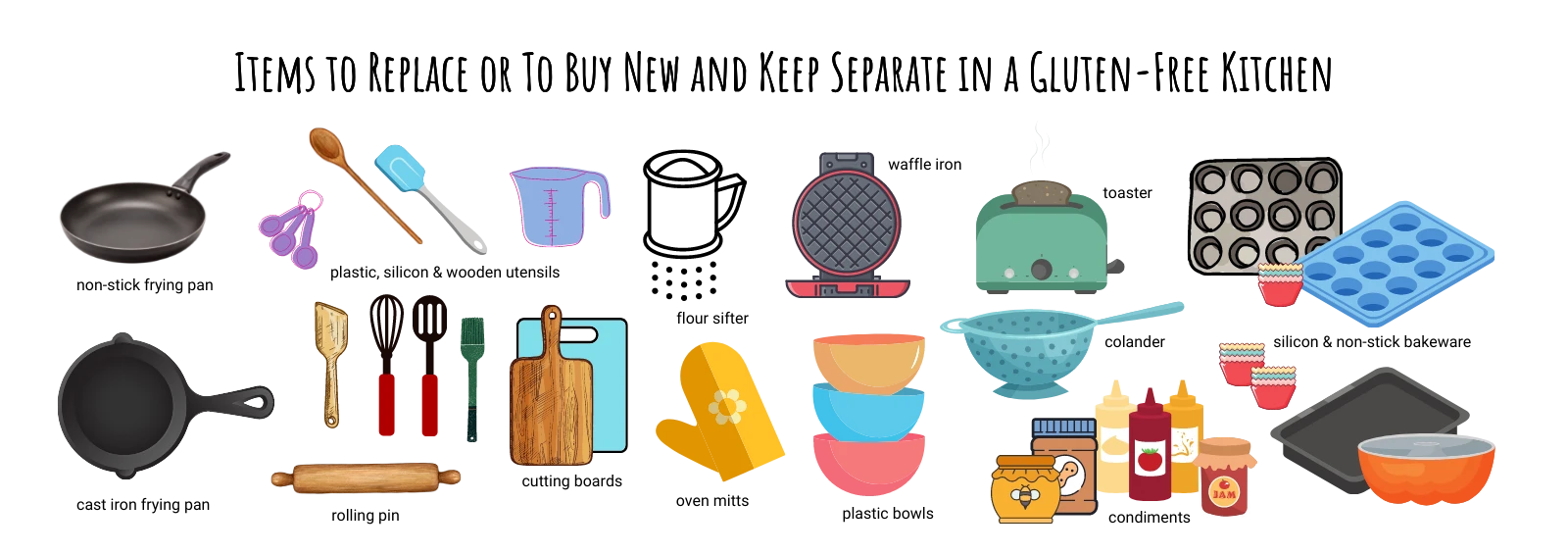
It is difficult to keep a kitchen that has both gluten and non-gluten items in it. It was so stressful trying to keep the kitchen safe. Someone was always using the wrong condiment jar and constantly contaminating it. Cooking separate meals and being diligent with the dishwashing and keeping the kitchen clean led us to eventually change over completely to a gluten-free kitchen.
Make the decision based on your family’s situation and needs. Some families are able to manage to keep things separate and are able to meet everyone’s needs, but we weren’t. The cross-contamination stopped once we switched over our entire kitchen.
Setting Up a Gluten-Free Home
Once you’ve set up your kitchen, it’s time to look at other products in the home that may contain gluten. Gluten can be found in other places in the home, garage, and in your yard. These things are often overlooked and can cause a person to continue being symptomatic and hinder healing. So if you’ve been gluten-free for a while, but aren’t feeling better, it might be time to look at what else could be hindering your overall wellbeing.
Some places you may find gluten are:
- hair and skincare products
- beauty products such as make-up, perfume, and lipstick
- deodorant
- shaving gel or creams
- toothpaste, mouthwash, oral care products
- sunscreen & bug sprays
- cleaning products
- medication, nutritional supplements, vitamins, and over-the-counter pain or flu remedies
- adhesives or glues
- lubricants
- art & craft items such as paint, play-dough, plaster of paris, finger paint, and paper mache
- pet food
While it’s not 100% necessary for people with Celiac Disease to use gluten-free shampoo or soap, some people find that using shampoos with gluten irritates their scalp or skin. Some people are sensitive to gluten in any form and will have a reaction if it touches their skin. I know people who get a headache from the smell of freshly baked bread at the grocery store.
Proceed with caution around these items that cause dust such as pet food and especially things that are ingested like medication and vitamins. Vitamin E, for example, is often derived from wheat germ.
When our family first switched over to being gluten-free, non-food items were not even on our radar and we suffered for a lot longer than we needed to. I wish that someone had told me to look into non-food products as a source of gluten contamination.
For Further Information
If you are looking for more in-depth information, about celiac disease, and the latest scientific research, check out the following websites. They are always looking at the latest studies and research to give you the most up-to-date information.
Let’s Get Cooking
The main reason for starting this website was to provide families who struggle with gluten intolerance and celiac disease with simple and tasty gluten-free recipes that help them to enjoy food again.
I believe that gluten-free meals can be wholesome and delicious without breaking the bank or leaving anyone feeling deprived. I also believe in sharing yummy gluten-free recipes that help YOU to enjoy celebrating again without feeling sick or left out. Go to the recipe index to find your next family favorite now that you know the answer to “What can I eat on a gluten-free diet?”
All of the recipes on this website are gluten-free by default and many of them are also dairy-free, plant-based, paleo, or whole 30 compliant.
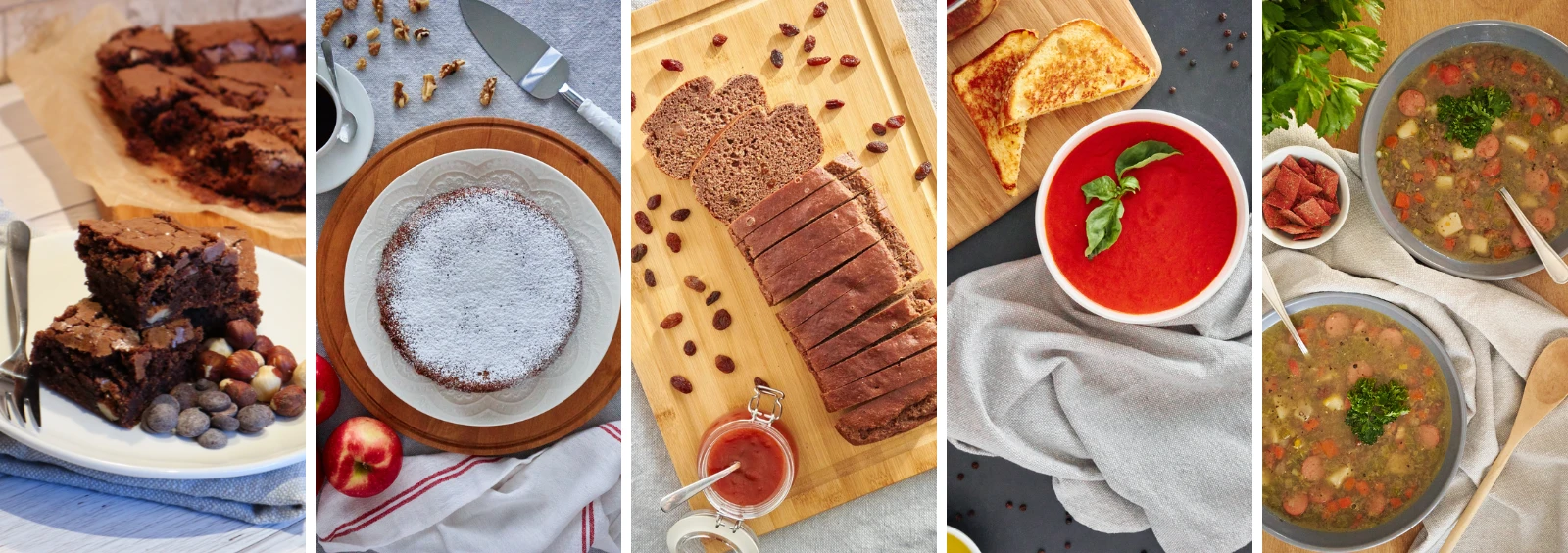
Professional Bio
Tina von Hatten is a gluten-free homesteader, food blogger, and gluten-free lifestyle coach at Under Three Acres. She creates simple and flavorful gluten-free farmhouse-inspired recipes from around the world so that everyone with gluten intolerance can enjoy celebrating again without feeling sick or left out.
Through her YouTube channel and website, she empowers families to embrace the gluten-free lifestyle with the peace of mind that they too can grow, and prepare their favorite comfort foods that are not only safe but tasty and worthy of sharing with others.
As her motto suggests, Tina believes that everyone with gluten intolerance deserves to live a life of gluten freedom, because YOU deserve to have your cake and eat it too.
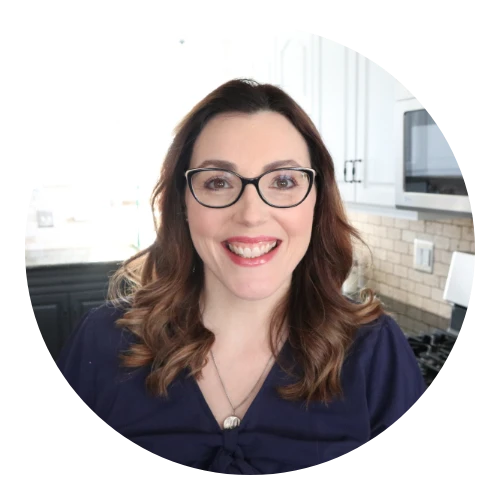
Let’s connect
You are welcome to connect with me on social media and check out our YouTube channel. Send me a recipe and/or topic request, and be sure to tag me when you try out my recipes.
If you are interested in being notified when I release new recipes, sign up to get the weekly newsletter. I look forward to getting to know you better.
